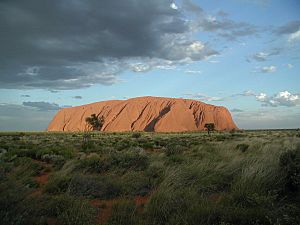Pitjantjatjara facts for kids
| Total population | |
|---|---|
| about 4,000 | |
| Regions with significant populations | |
| Languages | |
| Pitjantjatjara | |
| Religion | |
| Traditional & Christianity | |
| Related ethnic groups | |
| Ngaanyatjarra, Yankunytjatjara |

The Pitjantjatjara are a group of Aboriginal Australian people. They live in the central Australian desert. These people call themselves Aṉangu. This word means "person" or "people" in their own language, Pitjantjatjara.
The Pitjantjatjara are part of a larger group called the Western Desert cultural bloc. They are closely connected to their neighbours, the Yankunytjatjara and the Ngaanyatjarra people. They can understand much of each other's languages. Today, about 4,000 Pitjantjatjara people live in small communities across their traditional lands.
Where the Pitjantjatjara Live
The traditional home of the Pitjantjatjara people covers a large area. This includes north-western South Australia and the south-west of the Northern Territory. Some communities are also found just over the border in Western Australia.
Their land is very important to them. It plays a big part in their culture and beliefs. In South Australia, many live in the Aṉangu Pitjantjatjara Yankunytjatjara Lands. This is where the Pitjantjatjara language is spoken most strongly.
In the Northern Territory, their land is south of Lake Amadeus. It includes Uluṟu and Kata Tjuṯa. These two places are among their most sacred sites.
Traditional Lifestyle
Historically, the Pitjantjatjara were a nomadic people. This means they moved around a lot. They lived in small family groups. They would travel from one rock hole to another. Their movements depended on where they could find water and food.
In the middle of the 20th century, many families started to settle in new communities. They built these communities together. Even with changes from the wider Australian community, they have kept their unique culture and identity.
See also
 In Spanish: Pitjantjatjara para niños
In Spanish: Pitjantjatjara para niños

